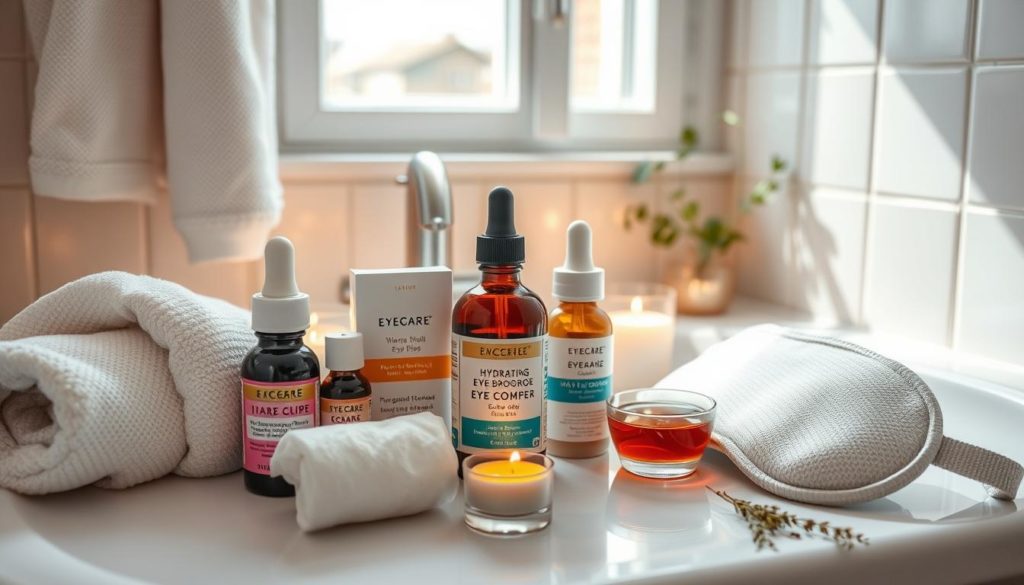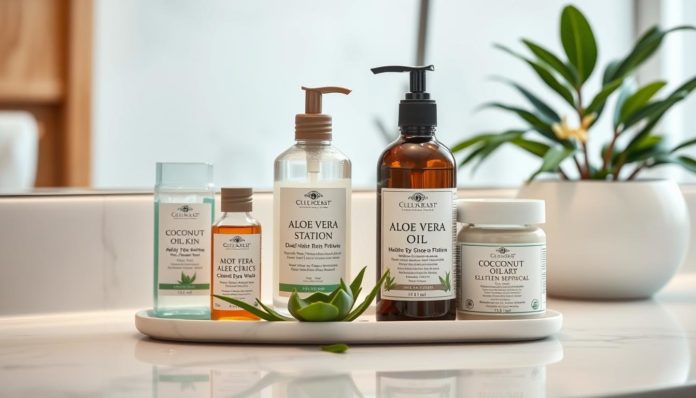Did you know over 16 million Americans suffer from dry eye syndrome yearly? That’s about one in every twenty people! These figures show how crucial it is to tackle dry eye and skin problems. They can hurt one’s life by causing discomfort. These issues can also affect how we see and look.
This article will give you details on how to handle dry eye and skin issues. We’ll share useful tips and natural treatments. Whether you need dermatological care for sensitive skin or are looking for natural remedies for dry eyes, our guide has you covered. It’s designed to help heal and comfort your eyes and skin.
Understanding the Causes of Dry Eye
To tackle dry eye, knowing why it happens is key. There are many reasons behind dry eye. Grasping these can lead to better, personalized treatment options.

Common Triggers
Certain medicines like antihistamines, decongestants, and antidepressants trigger dry eye. Getting older also affects it. Tear production often drops after the age of 50.
Medical Conditions Impacting Tear Production
Conditions such as Sjögren’s syndrome, rheumatoid arthritis, and lupus reduce tear production. These diseases attack moisture-making glands in the body. This shows why treating both the eyes and skin as a whole is crucial.
Environmental Factors
Living in dry or windy places, too much screen time, and being around smoke harm the eyes. Making your home more humid, wearing glasses for protection, and taking breaks from screens helps. These steps are simple but can greatly help.
Diagnosis and Tests for Dry Eye Syndrome
To identify dry eye syndrome, eye care professionals carry out various tests. These tests make sure treatments meet individual needs. People using holistic skincare in their daily routines find this especially helpful.
Comprehensive Eye Exam
The first step is a detailed eye exam. The eye doctor will look into the patient’s health and eye history. Symptoms and potential inflammation or other issues are checked too. This complete check helps plan out skincare for those with sensitive skin alongside dry eye syndrome.
Tear Volume Measurement Tests

Checking how much tears a person produces is key. Common ways to do this include:
- Schirmer Tear Test: A strip of filter paper measures tears under the lower eyelid. The strip’s wetness shows tear amount.
- Phenol Red Thread Test: This is like the Schirmer test but uses a special thread.
These methods clarify tear production levels. They also help suggest skincare moves to ease dry eye discomfort.
Quality Assessment of Tears
It’s also vital to check tear quality. The osmolarity test and dye eye drops help do this. They spot any lack in tear make-up.
| Test | Purpose | Insights |
|---|---|---|
| Osmolarity Test | Checks tear quality | Identifies imbalances in tear film |
| Dye Eye Drops | Stains the surface of the eye | Shows damaged areas on the cornea |
Knowing about tear quality and amount leads to tailored treatments. This includes skincare tailored for sensitive skin. It gives patients an all-in-one solution for both eye and skin health.
Natural Remedies for Dry Eyes
Dry eyes feel uncomfortable, but you can find relief. Try natural remedies and make lifestyle changes for healthier eyes.
Dietary Adjustments
Eating right helps dry eyes. Foods like flaxseed and salmon are rich in omega-3s. They keep your eye’s oil glands working well.
Hydration Techniques
Stay hydrated to fight dry eyes. Drink water all day. This improves tear production. Limit caffeine and alcohol, as they dry you out.
Holistic Eyewear Solutions
Wearing the right glasses makes a difference. Sunglasses protect against wind and dust. Also, a humidifier at home adds moisture to the air.
| Natural Remedy | Benefit |
|---|---|
| Foods Rich in Omega-3 | Supports oil gland function |
| Hydration | Maintains tear production |
| Protective Eyewear | Shields eyes from irritants |
Effective Nonprescription Products
For those who deal with dry eyes and skin irritation every day, finding the right products is a must. Adding certain items to your care for sensitive skin can ease discomfort. This brings the relief you really need.
Artificial Tears
Artificial tears are a top pick for quick dry eye comfort. These drops act like your own tears to moisten your eyes. They are great for calming the eye area and work well with care routines for sensitive skin.
Gels and Ointments
For relief that lasts longer, try gels and ointments. They keep your eyes moist, which is great at night. They help with dry eyes and fit into caring for irritated skin, offering lasting moisture and defence.
Eyelid Washes
It’s important to keep your eyelids clean and healthy, especially if your skin is sensitive. Using eyelid washes regularly reduces swelling and keeps oil glands unclogged. Adding them to your daily sensitive skin care can help control and prevent discomfort.
Prescription Treatments for Dry Eye
When over-the-counter options don’t help, prescription treatments for dry eye syndrome can be effective. These treatments work by boosting natural tear production and improving eye health.
Antibiotics and Anti-inflammatory Medications
Doctors often prescribe antibiotics and anti-inflammatory medicines for dry eye caused by blepharitis. These help ease eyelid swelling and fight infections. Using warm compresses and lid scrubs can make these treatments work better.
Cyclosporine Eye Drops
Cyclosporine eye drops are key for treating dry eye syndrome. They reduce eye inflammation and help make more tears over time. NYU Langone Health says they’re especially good for severe cases.
Tear-stimulating Medicines
Tear-stimulating meds, or secretagogues, offer hope for dry eye relief. They get the glands to make natural tears, attacking the syndrome’s cause. Following your doctor’s advice can boost symptoms and eye comfort.
Trying these prescription options can better the lives of those with dry eye syndrome. It can really help them feel better.
Managing Skin Irritation and Sensitivity
Treating sensitive skin is about being gentle. Knowing the right way to care for your skin can really help with managing dry eye and skin issues.
Gentle Cleansing Techniques
Gentle cleansing is a must for sensitive skin. Look for soaps without harsh chemicals or strong smells. These kinder products help avoid irritation and keep the skin healthy.
Moisturizing Strategies
Keeping your skin moisturized is key. Choose products with ingredients like hyaluronic acid or ceramides. Use them right after washing your face to seal in the moisture and make your skin glow.
Natural Skincare Products
Natural skincare plays a big role in a gentle skincare routine. Using products made with only natural stuff is safer. Try to find things with aloe vera, chamomile, or oatmeal for calm and happy skin.
| Skin Concern | Recommended Ingredient | Product Type |
|---|---|---|
| Dryness | Hyaluronic Acid | Moisturizer |
| Irritation | Aloe Vera | Gel |
| Redness | Chamomile | Cream |
Soothing Solutions for Skin Irritation
There are many options that offer quick relief and lasting benefits for skin irritation. Learning to use these options well can make a big difference for sensitive skin.
Cooling Gels
Cooling gels can quickly calm skin irritation. They lessen redness and swelling fast. Just a small amount on the sore spot brings comfort.
Brands like Neutrogena and La Roche-Posay make gels just for sensitive skin. They are both effective and gentle.
Aloe Vera Applications
Aloe vera has been used for a long time for its healing touch. It soothes and calms inflamed skin well. Putting it on regularly helps with itchiness and healing faster.
For natural care, aloe vera gels from brands like Banana Boat and Nature Republic are good choices. They work well for sensitive skin.
Oatmeal Baths
Oatmeal baths can really help too. Putting colloidal oatmeal in a warm bath soothes itching and irritation.
This method is great for its natural soothing effects. It’s a top choice for conditions like eczema and dermatitis. For more info, check out WebMD’s guide.
Here’s a short comparison of how each remedy helps:
| Remedy | Benefits |
|---|---|
| Cooling Gels | Reduces redness and swelling |
| Aloe Vera Applications | Calms inflamed skin; reduces itchiness |
| Oatmeal Baths | Relieves itching; soothes dry, irritated skin |
Using these remedies in your daily care can make your skin feel a lot better. They offer quick relief and lasting healing for sensitive skin.
Holistic Approach to Eye and Skin Health
Understanding a holistic approach to eye and skin health means knowing lifestyle factors affect both. Instead of just treating symptoms, adding integrative therapies and balanced diets is key. This broad view aims to boost overall wellness and help with dry eye and skin problems.
Integrative Therapies
Integrative therapies like acupuncture can boost circulation and lessen inflammation. Light therapy aids in healing too. These methods tackle root causes, not just symptoms. They offer better, long-lasting results for eye and skin issues.
Mindfulness and Stress Reduction
Stress worsens dry eyes and skin. Using mindfulness like meditation, yoga, or deep-breathing helps control stress. Reducing stress boosts eye and skin health by cutting down on inflammation and other related symptoms.
Balanced Nutrition
Good nutrition is essential for eye and skin health. A diet loaded with vitamins, minerals, and antioxidants strengthens your body’s defenses. Omega-3 fatty acids from salmon and flaxseeds reduce inflammation. Eating various fruits and vegetables provides vital nutrients for healthy skin and eyes.
FAQ
What are common triggers for dry eye?
Dry eye can be triggered by some medications, aging, and environment. Dry or windy weather and smoke exposure are key factors. Knowing these triggers helps find the right treatment.
How do medical conditions impact tear production?
Conditions like autoimmune diseases can lower tear production. This can make dry eye worse. Treating these health issues is crucial for managing dry eye.
What environmental factors contribute to dry eyes?
Factors like dry or windy weather and smoke can cause dry eyes. They speed up tear loss or irritate the eyes.
What tests are used for diagnosing dry eye syndrome?
To diagnose dry eye, doctors start with an eye exam. They may also use tests like the Schirmer tear test and dye eye drops. These tests measure tear volume and quality.
How can dietary adjustments help with dry eyes?
Eating foods rich in omega-3 fatty acids helps. Foods like flaxseed and salmon support tear production. This can ease dry eye symptoms.
What are holistic hydration techniques for dry eyes?
Drinking lots of water and wearing protective eyewear are good strategies. They help keep tears healthy and protect against dryness causes.
What are effective nonprescription products for dry eyes?
Artificial tears, gels, and ointments offer quick relief. Artificial tears help with moisture, while gels and ointments provide long-term lubrication.
What prescription treatments are available for dry eye?
Some treatments include antibiotics and anti-inflammatories for eyelid issues. Also, cyclosporine eye drops for cornea inflammation, and medicines that help make more tears.
How can I manage sensitive skin to prevent irritation?
Gentle cleansing and regular moisturizing are key. Choose natural skincare without harsh chemicals. This approach promotes better skin health.
What are some soothing solutions for immediate skin irritation relief?
To soothe irritated skin, try cooling gels, aloe vera, or oatmeal baths. These can reduce redness and itchiness effectively.
What holistic approaches support eye and skin health?
Acupuncture, light therapy, and stress reduction are helpful. Eating a balanced diet full of nutrients and healthy fats is also important for eye and skin health.


